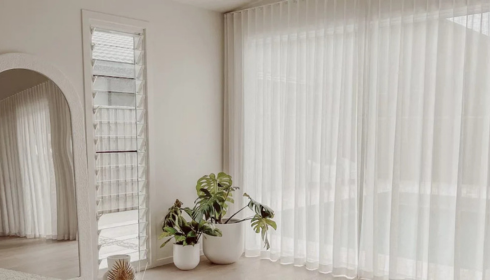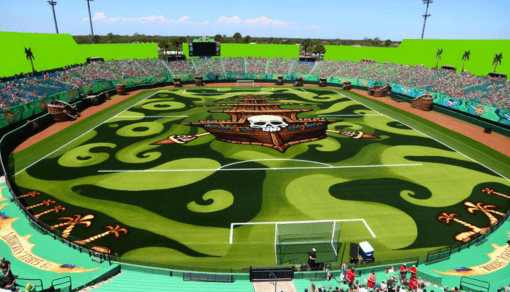Curtain Trends 2025: Vision’s Stylish Solutions for Penrith Homes

Explore the latest curtain trends for 2025 with Vision’s stylish solutions tailored for Penrith homes. From innovative designs to functional fabrics, discover how curtains can elevate your living spaces with a perfect blend of aesthetics and practicality. Stay ahead of the curve with these trendsetting window treatments.
Sustainable Fabrics and Materials
Sustainable fabrics and materials play a crucial role in reducing the environmental impact of the fashion industry. These materials are produced using processes that minimize resource consumption, waste generation, and pollution. For example, organic cotton is grown without the use of synthetic pesticides or fertilizers, making it better for the environment and the health of farmers. Similarly, recycled polyester is made from post-consumer plastic bottles, diverting waste from landfills and reducing the demand for virgin polyester production, which is a major contributor to greenhouse gas emissions. Other sustainable fabrics include hemp, linen, Tencel, and bamboo, all of which require less water and energy to produce compared to conventional materials.
In addition to being environmentally friendly, sustainable fabrics and materials also offer benefits such as improved durability, breathability, and biodegradability. For instance, hemp is a strong and durable fiber that becomes softer with each wash, making it a long-lasting material for clothing and accessories. Tencel, a fiber made from sustainably sourced wood pulp, is known for its silky smooth texture and moisture-wicking properties, making it ideal for activewear and everyday clothing. By choosing sustainable fabrics and materials, consumers can support ethical practices in the fashion industry, reduce their carbon footprint, and contribute to a more environmentally conscious society.
Vision Blinds & Shutters offers environmentally conscious options, like their Australian-made window furnishings that complement sustainable living. Their commitment to quality and service mirrors the benefits of sustainable fabrics, helping customers create beautiful, eco-friendly spaces while supporting local industry and reducing environmental impact.
Smart Technology Integration
Smart technology integration refers to the seamless incorporation of cutting-edge technologies into various aspects of daily life, business operations, and infrastructure to enhance efficiency, productivity, and user experience. This integration involves the use of interconnected devices, sensors, and data analytics to automate processes, collect and analyze data in real-time, and make intelligent decisions. In the context of smart homes, for example, integrating smart technology allows homeowners to control lighting, temperature, security systems, and entertainment devices remotely through a smartphone or voice commands. In business settings, smart technology integration can optimize supply chain management, improve customer service, and streamline operations through the use of IoT devices, AI-powered analytics, and cloud computing.
One of the key benefits of smart technology integration is its ability to create interconnected ecosystems that enable seamless communication and data sharing across different devices and platforms. This interconnectedness fosters collaboration, improves decision-making processes, and facilitates the automation of routine tasks. By integrating smart technology into critical infrastructure such as transportation systems, energy grids, and healthcare facilities, cities can become more sustainable, resilient, and responsive to the needs of their residents. Moreover, smart technology integration can also lead to cost savings, as automation reduces the need for manual intervention and helps in optimizing resource utilization. Overall, smart technology integration holds immense potential to transform industries, improve quality of life, and drive innovation in the digital age.
Minimalist Designs for Modern Homes
Minimalist designs for modern homes focus on simplicity, functionality, and clean lines to create a sense of spaciousness and tranquility. These designs often feature neutral color palettes, sleek furniture, and uncluttered spaces to promote a sense of calm and relaxation. Minimalist interiors typically prioritize quality over quantity, with a focus on carefully selected pieces that serve both a practical and aesthetic purpose. By eliminating unnecessary clutter and decorative elements, minimalist designs allow natural light to flow freely through the space, creating an open and airy atmosphere. This design approach is perfect for those who prefer a clean and uncluttered living environment, as it promotes a sense of clarity and simplicity in everyday living.
In addition to their aesthetic appeal, minimalist designs for modern homes also offer practical benefits. The emphasis on functionality means that every piece of furniture and decor serves a purpose, maximizing the use of space and promoting efficient living. Minimalist interiors are also easier to maintain and keep clean, as there are fewer items to dust and clutter to organize. The minimalist approach to design encourages mindfulness and intentionality in the way we interact with our living spaces, promoting a sense of mindfulness and well-being. Overall, minimalist designs for modern homes offer a harmonious blend of aesthetics and functionality, creating a serene and inviting environment for contemporary living.
Nature-Inspired Patterns and Prints
Nature-inspired patterns and prints have been a timeless source of inspiration for designers across various industries, from fashion to interior design. Drawing upon the intricate designs found in the natural world, these patterns often feature elements such as floral motifs, leafy patterns, animal prints, and organic textures. The beauty of nature is translated into visually appealing patterns that evoke a sense of serenity, vitality, and harmony. These designs not only capture the essence of the natural world but also bring a touch of the outdoors into our everyday lives, creating a connection with the environment that is both comforting and captivating.
The versatility of nature-inspired patterns and prints allows them to be incorporated into a wide range of products and applications. From clothing and accessories to home decor and stationery, these designs add a touch of sophistication and elegance to any item. Whether it’s a delicate floral pattern on a summer dress, a bold animal print on a statement piece of furniture, or a subtle leaf motif on a set of bedding, nature-inspired patterns can instantly elevate the aesthetic appeal of a product. By incorporating these patterns into our surroundings, we are reminded of the beauty and diversity of the natural world, fostering a deeper appreciation for the environment and its wonders.
Vision curtains Penrith offer a perfect example of how nature-inspired designs can transform interiors. With high-quality, Australian-made window furnishings, they seamlessly blend sophistication with the serene beauty of nature, enhancing any living space with elegance and style.
Customization and Personalization
Customization and personalization are key elements in creating unique and tailored experiences for customers. Customization involves offering products or services that can be modified or designed according to the specific preferences of individual customers. This allows businesses to cater to diverse needs and preferences, enhancing customer satisfaction and loyalty. By providing customization options, businesses can create a sense of exclusivity and luxury, making customers feel valued and appreciated. Whether it’s personalized products, custom packaging, or bespoke services, customization adds a personal touch that sets a brand apart in a competitive market.
Personalization, on the other hand, involves tailoring the customer experience based on data and insights gathered about individual preferences, behaviors, and interactions. This can include personalized recommendations, targeted marketing messages, and specialized promotions that are relevant to each customer’s needs and interests. Personalization helps businesses build stronger relationships with customers by delivering relevant and timely content that resonates with their unique preferences. By utilizing technology such as artificial intelligence and data analytics, businesses can create personalized experiences across various touchpoints, driving engagement, and fostering brand loyalty. Overall, customization and personalization play a vital role in creating meaningful connections with customers and enhancing the overall customer experience.
Bold Colors and Statement Pieces
Bold colors and statement pieces play a crucial role in interior design, adding personality and visual interest to a space. Bold colors such as deep blues, vibrant yellows, and rich reds can create a striking focal point in a room and evoke different emotions. These colors can be incorporated through accent walls, furniture pieces, or accessories to make a bold statement. Statement pieces, on the other hand, are unique and eye-catching items that instantly draw attention and become conversation starters. These pieces can range from an oversized artwork, a bold patterned rug, a unique light fixture, or a sculptural furniture piece that adds drama and character to a room. By combining bold colors with statement pieces, a space can be transformed into a dynamic and visually appealing environment that reflects the homeowner’s style and personality.
When using bold colors and statement pieces in interior design, it is essential to strike a balance to avoid overwhelming the space. One approach is to use bold colors as accents against a neutral backdrop to create a harmonious and balanced look. This allows the statement pieces to shine without competing for attention. Additionally, incorporating bold colors and statement pieces strategically can help create a cohesive design scheme that ties the elements together. Mixing different textures, patterns, and styles can also add depth and interest to a room while ensuring that the bold colors and statement pieces complement each other. Ultimately, bold colors and statement pieces offer a creative way to infuse energy and individuality into a space, making it a reflection of the homeowner’s unique taste and style.
Energy-Efficient Window Treatments
Energy-efficient window treatments are an essential component of any sustainable home design. These treatments help to minimize energy loss through windows, which can account for a significant portion of a home’s heating and cooling expenses. Options such as cellular shades, insulated curtains, and window films are designed to trap air and create a barrier between the window and the interior of the home, reducing heat transfer. By investing in energy-efficient window treatments, homeowners can lower their energy bills, improve the comfort of their living spaces, and reduce their carbon footprint.
In addition to their energy-saving benefits, energy-efficient window treatments also provide added privacy, light control, and noise reduction. Cellular shades, for example, can help to muffle outside noise and create a more peaceful indoor environment. Insulated curtains not only help to regulate temperature but also block out unwanted light, creating a cozy and darkened atmosphere for better sleep. These window treatments offer a versatile solution for homeowners looking to enhance the functionality and efficiency of their windows while also improving the overall comfort and aesthetics of their living spaces.
Versatile Layering Techniques
Versatile layering techniques are an essential aspect of creating stylish and functional outfits. Layering allows individuals to mix and match different pieces of clothing to achieve a variety of looks that are suitable for different occasions and weather conditions. One popular layering technique is the classic combination of a basic t-shirt or blouse underneath a cardigan or blazer. This simple yet versatile technique can be dressed up or down depending on the choice of accessories and footwear. Another effective layering technique involves mixing textures and lengths to create visual interest and depth in an outfit. Pairing a chunky knit sweater with a flowy midi skirt, for example, adds dimension and creates a balanced silhouette.
Moreover, versatile layering techniques offer practical benefits beyond aesthetics. Layering allows individuals to easily adjust their clothing to accommodate changing temperatures throughout the day. By adding or removing layers, individuals can stay comfortable and stylish regardless of the weather. Additionally, layering provides a functional solution for transitioning between indoor and outdoor environments, such as moving from a cold office to a warmer outdoor setting. With the right layering techniques, individuals can create versatile outfits that are both fashionable and functional, making it easier to adapt to different situations while maintaining a polished and put-together look.
Textured and Embellished Curtains
Textured and embellished curtains add a touch of luxury and sophistication to any room. The use of various textures, such as velvet, silk, or linen, creates visual interest and depth, making the curtains a focal point of the space. Textured curtains not only provide a tactile experience but also enhance the overall aesthetic of the room by adding dimension and warmth. Embellishments like embroidery, beading, or tassels can elevate the curtains to a new level of elegance, making them a statement piece in the decor. These intricate details can transform a simple window treatment into a work of art, adding a touch of opulence and glamour to the room.
In addition to their aesthetic appeal, textured and embellished curtains also offer practical benefits. The varying textures can help to control light and privacy, allowing you to customize the ambiance of the room. Thicker textures like velvet or brocade can provide insulation, helping to regulate the temperature of the room and reduce energy costs. The embellishments, such as beads or sequins, can catch and reflect light, adding a subtle sparkle to the space. Overall, textured and embellished curtains are a versatile design element that can enhance the beauty and functionality of any room in your home.
Retro and Vintage Revival Styles
Retro and vintage revival styles have made a significant comeback in recent years, drawing inspiration from past decades to create a nostalgic and timeless aesthetic. The retro style typically refers to design elements that are inspired by the 1950s, 60s, and 70s, featuring bold colors, geometric patterns, and sleek lines. This style often incorporates mid-century modern furniture, vintage appliances, and iconic pop culture references that evoke a sense of nostalgia and charm. Retro interiors typically have a playful and vibrant feel, with a mix of vintage and modern elements that create a unique and eclectic look.
On the other hand, the vintage revival style focuses on bringing back the elegance and sophistication of bygone eras, such as the Victorian, Art Deco, or Art Nouveau periods. This style embraces ornate details, luxurious materials, and intricate craftsmanship to create a sense of old-world glamour and refinement. Vintage revival interiors often feature antiques, heirloom pieces, and vintage-inspired decor items that add a touch of history and character to a space. By blending classic elements with contemporary design trends, the vintage revival style creates a sense of timeless beauty and sophistication that transcends fleeting trends and fads.
Leave a Reply
You must be logged in to post a comment.




Leave a Comment